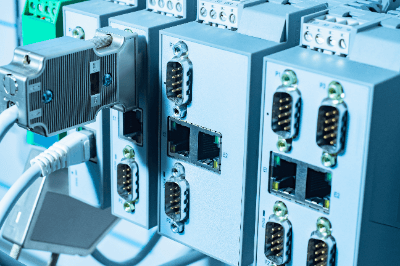What Is an Embedded PC?

An embedded PC refers to a computer system integrated into a device, designed for specific applications.
Embedded PCs are incorporated to achieve specific functions in machinery, devices, and other equipment. They find applications in a wide range of products requiring control, including industrial equipment, medical devices, and household appliances.
Uses of Embedded PC
Embedded PCs differ from general-purpose computers in several aspects:
- Long-Term Stable Supply: General-purpose computers undergo frequent model changes, making them unsuitable for industrial applications. Embedded PCs require long-term stable supply and support for components such as CPUs and operating systems (OS).
- High Reliability: Computers used for office tasks operate in relatively calm environments with moderate uptime and conditions. Concerns arise when applying them to industrial purposes due to the potential for malfunctions. Embedded PCs use durable and reliable components.
- High Environmental Resistance: Embedded PCs can withstand harsh environmental conditions such as temperature, humidity, dust, vibration, electromagnetic interference, and possess waterproof capabilities.
- Troubleshooting Investigation: In case of malfunctions, thorough investigations are conducted on which component failed, why it failed, and whether the issue affects other products. General-purpose computers often rely on component replacement with insufficient investigation.
- Differences in Input/Output: Embedded PCs feature a greater variety of input and output options compared to general-purpose computers.
Specific Applications of Embedded PC:
- Factory Automation and Industrial Equipment: Robots, manufacturing machinery, inspection equipment, etc.
- Medical Devices: CT (Computed Tomography) scanners, MRI (Magnetic Resonance Imaging) machines, X-ray examination equipment, etc.
- Network Equipment: Servers, modems, communication control devices, etc.
- Measurement/Precision Instruments: Gas chromatographs, etc.
- Transportation Equipment: Railway vehicles, automobiles, etc.
Principles of Embedded PC
1. Differences from Microcontrollers
Microcontrollers, similar to embedded PCs, are mainly used in consumer electronics for specific and localized roles when integrated into devices. In contrast, embedded PCs oversee the entire device, coordinating connections with multiple microcontrollers within the device, interfacing with external devices, and facilitating communication with users to perform the intended operations.
2. Advanced Data Processing and Graphics Capabilities
Embedded PCs use operating systems like Windows or Linux, resembling general-purpose computers or servers. Integrating Embedded PCs into devices allows for advanced data processing and the use of high-dimensional graphics functions.
3. Replication of Skilled Worker Operations
The use of high-performance computers enables the mechanization and automation of delicate operations performed by skilled workers.
4. Collaboration with Design and Manufacturing Processes
In manufacturing processes, design using CAD (Computer-Aided Design) is prevalent. Computerizing devices allows for the direct integration of design data from CAD systems to manufacturing equipment, enhancing productivity.
5. Utilization in Medical Devices
In medical devices, embedded PCs manage data such as diagnostic and examination information, eliminating the need to carry patient records within the facility. Additionally, there are expectations for applications such as AI (Artificial Intelligence) -assisted diagnosis and advancements in highly specialized medical practices.
6. Risks of General-Purpose Computers
When equipment manufacturers adopt general-purpose computers for developing new models, these computers may have a short product lifespan and prove disadvantageous in terms of support. Therefore, many equipment manufacturers increasingly turn to computer specialists to develop dedicated embedded PCs.
Selection of Embedded PC
1. Processing Capability
Selecting a PC and software with sufficient processing power relative to the required specifications is paramount.
2. Environmental Considerations
It is crucial to thoroughly consider the environmental conditions of the device where the embedded PC will be installed. Factors such as operating hours, lifespan, temperature, humidity, vibrations, space, and connectivity with other devices need to be taken into account.
3. Long-Term Support
Since devices with embedded PCs are expected to operate for extended periods, the embedded PC must also have a long lifespan. Long-term support for the PC, especially in terms of component availability, is a critical factor.
4. Disaster Response
In times of disasters like earthquakes or typhoons, uninterrupted supply and service availability are essential requirements.
Trends in Embedded PC
1. Continuity
Continuity is indispensable for embedded PCs, allowing users to operate devices for extended periods. Long-life design and continuous component supply are essential.
2. Space Efficiency
As devices become more feature-rich, compact, and easily integrable PCs become advantageous. Enhanced PC performance and functionality are also necessary.
3. Standardization
A trend in embedded PCs ranges from expensive specialized units to cost-effective common models. Standardizing components used is also essential.
4. Utilization of AI Technology
AI technology is becoming widespread in the industrial sector. The integration of AI into embedded PCs allows for the analysis of large data from IoT sensors, self-diagnosis of device conditions, and improved precision in inspection devices.